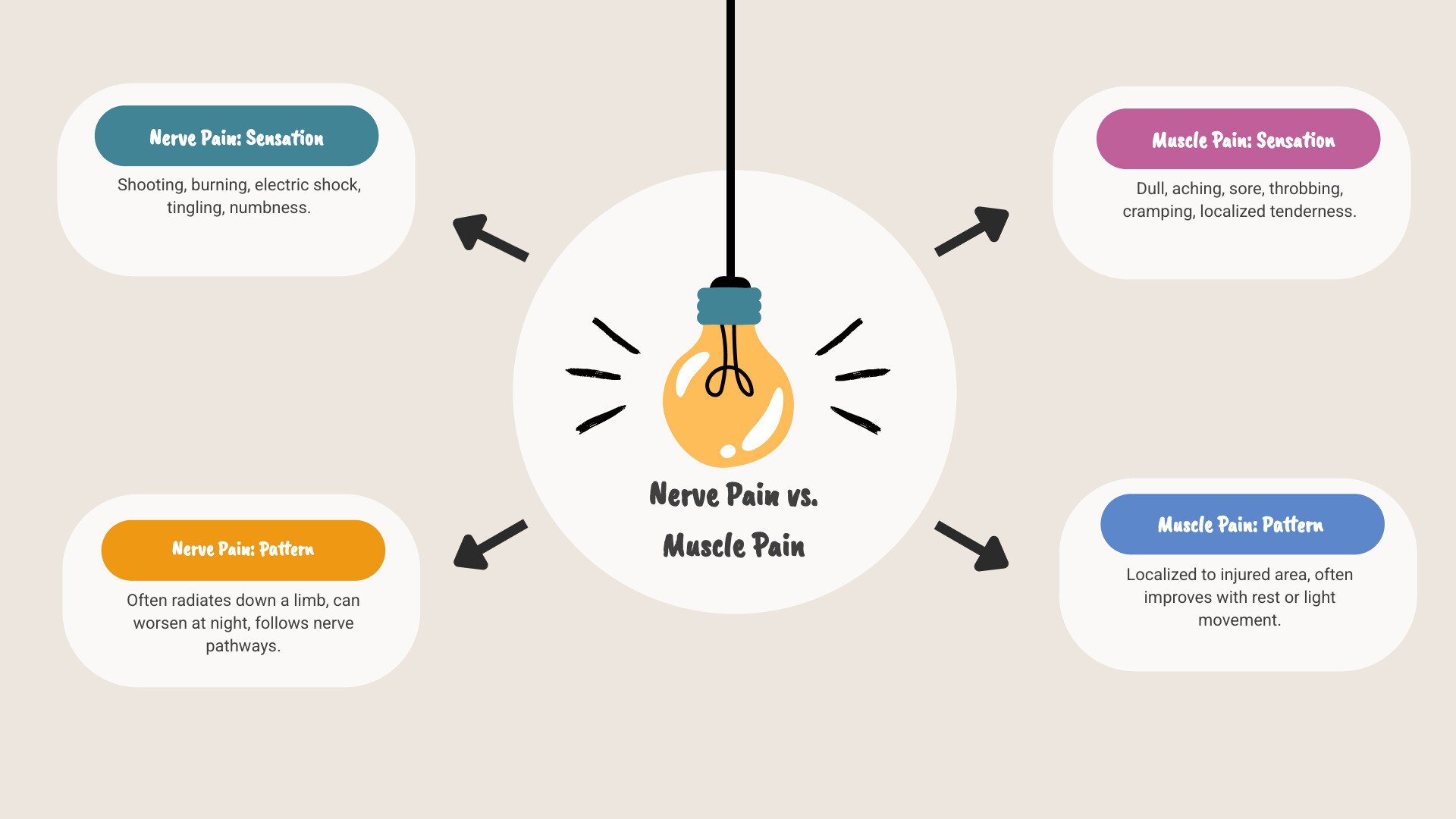Why Understanding Leg Nerve Pain Relief Matters
Learning how to relieve nerve pain in leg is crucial for the millions affected by it. Leg nerve pain can feel like a burning, shooting, or tingling sensation that disrupts sleep and makes simple activities feel impossible. With conditions like sciatica affecting up to 40% of people and diabetic neuropathy on the rise, finding effective solutions is more important than ever.
The good news is that relief is achievable. Between 80-90% of people with sciatic nerve pain improve within weeks with proper care. This guide will show you how to manage leg nerve pain with proven methods, from immediate at-home strategies like temperature therapy and topical creams to long-term solutions like gentle exercise and medical treatments.
I'm Tony Enrico, and I've dedicated my career to helping people find freedom from nerve and muscle pain. My mission is to ensure no one has to let the question of how to relieve nerve pain in leg limit their life.

Understanding Leg Nerve Pain: Causes and Symptoms
Unlike a pulled muscle (nociceptive pain), nerve pain (neuropathic pain) originates from the body's wiring system. When nerve fibers in your legs are damaged or irritated, they send distorted signals to your brain, resulting in pain even without an injury. This can lead to central sensitization, where your nervous system becomes hypersensitive.
What causes this? The most common culprits are sciatica, affecting about 40% of people, and diabetic neuropathy, which accounts for 30% of cases. Other causes include pinched nerves from herniated discs, injuries, infections like shingles, autoimmune diseases, alcohol use disorder, and vitamin deficiencies (particularly B vitamins). For a deeper look, see our guide on Decoding Nerve Pain.
Distinguishing Nerve Pain Symptoms
Knowing if you have nerve or muscle pain is key, as the treatments differ. Nerve pain is often described as shooting, burning, stinging, or like an electric shock. It frequently radiates down the leg and may be accompanied by numbness, tingling, or muscle weakness. A telltale sign is that nerve pain often worsens at night.
Muscle pain, in contrast, is typically a dull, localized ache that improves with rest.
| Symptom Characteristic | Nerve Pain (Neuropathic) | Muscle Pain (Nociceptive) |
|---|---|---|
| Sensation | Burning, shooting, electric shock, stabbing, tingling, numbness | Dull ache, throbbing, sharp, soreness, tenderness |
| Location | Often radiates along a nerve pathway (e.g., down the leg), can be widespread | Usually localized to the injured muscle or joint area |
| Triggers | Light touch, cold, pressure, movement, often spontaneous | Pressure on injury site, movement of affected muscle/joint |
| Timing | Can worsen at night, persistent, often chronic | Improves with rest, usually acute (short-term) unless chronic condition |
| Associated Symptoms | Weakness, altered sensation, loss of reflexes | Swelling, bruising, stiffness, limited range of motion |
Common Causes of Nerve Pain in the Legs
Understanding the cause helps target treatment. Here are the most common issues:
- Herniated Discs: A cushion between your vertebrae presses on a nerve root, causing sciatica.
- Spinal Stenosis: A narrowing of the spinal canal compresses nerves.
- Piriformis Syndrome: A buttock muscle squeezes the sciatic nerve.
- Radiculopathy (Pinched Nerve): A nerve root is compressed as it exits the spine.
- Diabetes Complications: High blood sugar damages nerves, leading to diabetic neuropathy.
- Injury or Trauma: Direct damage to nerves in the leg or back.
- Other Conditions: Alcohol use disorder, shingles, and vitamin B deficiencies can also cause nerve pain.
Immediate At-Home Strategies for Leg Nerve Pain
When leg nerve pain flares up, you can take immediate action at home to find relief. These first-aid strategies can calm irritated nerves and put you in control.

Rest, Posture, and Positional Relief
How you position your body can provide instant relief. While complete bed rest is not recommended, smart positioning and movement are key.
- Sleep: Aim for 7-9 hours. Sleep is essential for nerve healing. Try sleeping on your side with a pillow between your knees or on your back with a pillow under them.
- Lift Your Legs: Prop your legs up at a 45-degree angle with pillows to reduce pressure on lower back nerves.
- Change Positions: Avoid staying in one position for too long. Move every 30 minutes to prevent nerve compression.
- Good Posture: Maintaining good posture aligns your spine and reduces strain on nerve pathways.
How to Relieve Nerve Pain in Leg with Temperature Therapy
Temperature therapy is a classic for a reason: it works. The key is knowing when to use cold versus heat.
- Ice Packs: For acute pain and inflammation, apply an ice pack wrapped in a towel for 15-20 minutes. Cold constricts blood vessels, reducing swelling and numbing the area.
- Heat Therapy: For chronic pain or after the first 48-72 hours, use a heating pad for 15-20 minutes. Heat increases blood flow, bringing oxygen to aid healing and relaxing tight muscles.
- Alternating: Many find relief by alternating 15 minutes of ice with 15 minutes of heat to improve circulation and reduce both inflammation and tension.
How to Relieve Nerve Pain in Leg with Topical Creams
Topical creams deliver pain-relieving ingredients directly to the source without the systemic side effects of oral medications.
- Capsaicin Cream: Derived from chili peppers, it depletes Substance P, a chemical that transmits pain signals. It may burn at first but desensitizes nerve endings with regular use.
- Menthol-Based Creams: These create a cooling sensation that acts as a counter-irritant, distracting your nerves from the pain.
Effective creams often combine multiple ingredients. Aloe Vera soothes irritated nerves, while Urea helps other active ingredients penetrate the skin more effectively. Other beneficial ingredients include Arnica, MSM, and essential oils like Frankincense and Myrrh. To learn more, see our guide on Specialized Nerve Pain Creams.
Topical creams are an easy, portable way to manage how to relieve nerve pain in leg as part of your daily routine.
How to Relieve Nerve Pain in Leg with Movement and Lifestyle Changes
While immediate relief is crucial, long-term management through gentle movement and smart lifestyle choices is the real game-changer for preventing future flare-ups.

These habits don't just mask pain—they address underlying issues to support your nerve health from the inside out.
The Role of Physical Therapy and Gentle Exercise
The right kind of movement is one of the most powerful tools for nerve pain relief. A physical therapist can design a program to address the root mechanical issues.
- Low-Impact Exercise: Activities like walking, swimming, or water aerobics improve circulation and strengthen supporting muscles without aggravating nerves.
- Gentle Stretching: Targeted stretches create space for nerves, reduce muscle tension, and improve flexibility. Hold each stretch for 30 seconds and avoid sharp pain.
- Nerve Glides: These specialized exercises help nerves move smoothly through surrounding tissues, preventing them from getting pinched.
- Core Strengthening: A strong core supports your spine, improves alignment, and reduces pressure on nerve roots. As experts note, physical therapy can help relieve symptoms by strengthening these muscles.
Lifestyle Changes for Nerve Health
Your daily habits play a massive role in nerve health. Small, consistent changes can lead to significant relief.
- Weight Management: Losing even a small amount of excess weight can dramatically reduce pressure on your spine and nerves.
- Quitting Smoking: Nicotine constricts blood vessels, impairing healing and increasing inflammation. Quitting improves blood flow to your nerves.
- Balanced Diet: Focus on anti-inflammatory foods and B-Vitamins (B1, B6, B12), which are crucial for nerve function. Copper-rich foods like nuts and leafy greens also help.
- Hydration: Drink plenty of water to support all cellular functions, including nerve health.
- Supportive Footwear: Comfortable shoes reduce pressure points and prevent additional strain on irritated nerves.
Complementary Therapies
These therapies can provide an extra layer of relief alongside conventional treatments.
- Massage Therapy: Relieves muscle tension that may be compressing nerves and promotes relaxation.
- Acupuncture: May help modulate pain signals and has been shown to be effective for certain types of pain.
- Chiropractic Care: Gentle adjustments can help align the spine and reduce pressure on nerves.
- Stress Management: Techniques like deep breathing, meditation, and mindfulness can break the cycle of stress and pain amplification.
Medical Treatments for Persistent Leg Nerve Pain
When home remedies and lifestyle changes aren't enough, seeking medical attention is a smart move. A doctor can provide a proper diagnosis and offer advanced treatments for chronic neuropathic pain.

When to See a Doctor and How Nerve Pain is Diagnosed
Certain red flags require immediate medical attention. See a doctor right away if you experience:
- Sudden, severe weakness in your leg
- Loss of bladder or bowel control
- Progressive numbness or weakness that is getting worse
- Pain that follows a recent injury
A doctor will perform a physical exam to check muscle strength, reflexes, and sensation. To diagnose the cause, they may order imaging tests. An MRI can reveal herniated discs or pinched nerves, while X-rays show bone issues. Electromyography (EMG) and nerve conduction studies can measure electrical activity in nerves and muscles to pinpoint the location and severity of nerve damage.
Medications and Advanced Procedures
Once a diagnosis is made, your doctor may recommend the following:
- Over-the-Counter (OTC) NSAIDs: Ibuprofen or naproxen can help with mild pain and inflammation.
- Prescription Medications: According to Harvard Health, several drug classes relieve nerve pain. These include anticonvulsants (like gabapentin) to calm overactive nerves and certain antidepressants (like duloxetine) that control pain signals. Muscle relaxers may be used for spasms. Opioids are typically a last resort for severe, short-term pain.
- Advanced Procedures: Epidural steroid injections deliver anti-inflammatory medicine directly to the spinal nerves for temporary relief. Nerve blocks use anesthetics to block pain signals from specific nerves. Surgery (e.g., discectomy) is a final option to relieve severe nerve compression when other treatments fail.
- Compression Socks: These can improve blood flow, reduce swelling, and ease numbness and tingling, especially for neuropathy-related pain.
Specific Treatments for Conditions like Diabetic Neuropathy
Managing diabetic neuropathy requires addressing both the symptoms and the underlying cause. For a full overview, see our guide on Navigating Nerve Pain with Diabetes.
The most critical step is strict blood sugar control to prevent further nerve damage. Specialized foot care is also essential to prevent infections and ulcers that can go unnoticed due to reduced sensation. TENS units (Transcutaneous Electrical Nerve Stimulation) can also be used to block pain signals with low-voltage electrical currents.
Frequently Asked Questions about Leg Nerve Pain
It's normal to have questions about a condition as challenging as nerve pain. Here are answers to some of the most common ones.
Can nerve pain in the legs be completely cured?
This depends on the cause. For acute issues like a pinched nerve or sciatica, a complete cure is often possible. In fact, 80%-90% of people with sciatica get better within a few weeks without surgery. The body has a remarkable ability to heal.
For chronic conditions like diabetic neuropathy, the focus shifts from a "cure" to effective long-term management. While the underlying damage may not be fully reversible, treatments can significantly reduce pain and improve your quality of life, allowing you to live a full, active life.
How long does it take for leg nerve pain to heal?
The healing timeline varies based on the cause, severity, and your overall health. Here are some general timelines:
- Acute Pinched Nerves: The outlook is positive, with over 85% of cases resolving within 8-12 weeks with conservative care.
- Sciatica: Most cases improve within four to six weeks.
- Diabetic Neuropathy: This is a chronic condition focused on long-term management rather than a finite healing period.
- Post-Surgery: Nerve regeneration can take three to six months.
Nerves heal slowly, so patience and consistent adherence to your treatment plan are key.
What is the fastest way to relieve nerve pain in the leg?
The fastest relief often comes from combining several immediate strategies:
- Positional Changes: Elevating your legs at a 45-degree angle can instantly reduce pressure on the sciatic nerve.
- Temperature Therapy: Apply an ice pack for 15-20 minutes to quickly numb the area and reduce inflammation.
- Topical Creams: Fast-acting creams with ingredients like menthol and capsaicin can soothe irritated nerves within minutes of application.
- Over-the-Counter NSAIDs: Ibuprofen or naproxen can start reducing pain and inflammation within an hour or two.
- Gentle Movement: A short, slow walk can alleviate pressure and release natural pain-relieving endorphins.
If these steps don't work or your pain is severe, consulting a doctor promptly is the fastest way to get a proper diagnosis and stronger interventions.
Conclusion: Taking Control of Your Leg Nerve Pain
Living with leg nerve pain can be challenging, but you are not powerless. Learning how to relieve nerve pain in leg is about building a personalized toolkit that combines immediate relief with long-term management.
The science is on your side: 80-90% of sciatica cases improve within weeks, and most pinched nerves resolve with conservative care. Even chronic conditions can be managed effectively. Your journey may involve trying different approaches, from temperature therapy and gentle stretches to lifestyle changes and medical guidance.
For many, a quality topical cream becomes an essential part of their daily routine for managing burning, tingling, or shooting pain. Natural ingredients like Aloe, Urea, and Menthol work together to provide targeted, fast-acting comfort right where you need it, without the systemic side effects of oral medications. It's the kind of relief you can count on anytime nerve pain threatens to disrupt your day.
Don't let nerve pain write your story. Take it one day at a time, be patient with your body, and use the strategies in this guide to find the relief you deserve. Freedom from nerve pain is within reach.
Find fast-acting relief with Neuropasil Nerve Pain Relief Cream
References
When it comes to your health, you deserve information backed by solid science. The statistics, studies, and recommendations in this guide are drawn from credible medical institutions and research.
We've drawn on insights from:
- Cleveland Clinic for information on sciatica and the health effects of poor posture.
- National Institute of Neurological Disorders and Stroke (NINDS) for details on pinched nerves.
- Harvard Health for research on drugs that relieve nerve pain.
- National Center for Biotechnology Information (NCBI) for studies on sleep's role in healing and the resolution rate of pinched nerves.
- American Academy of Orthopaedic Surgeons (AAOS) for information on cervical radiculopathy.
- WebMD for statistics on sciatica recovery.
- Healthline and Medical News Today for practical guides on remedies.
- Venosan for insights on compression socks.
- Pain Specialists of Brighton for tips on relieving nerve pain.
We also linked to our own in-depth Neuropasil articles, including Decoding Nerve Pain, Navigating Nerve Pain with Diabetes, and our Guide to Specialized Nerve Pain Creams.














